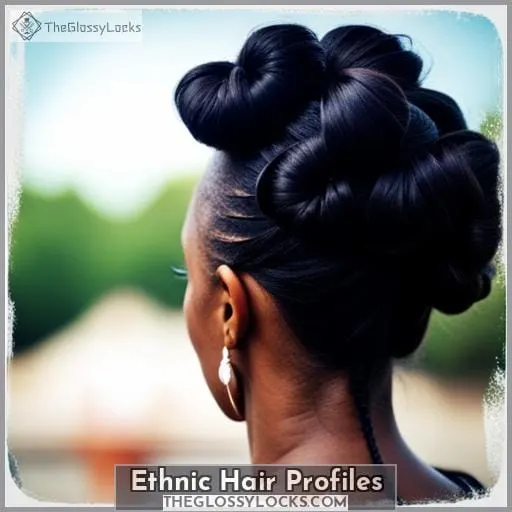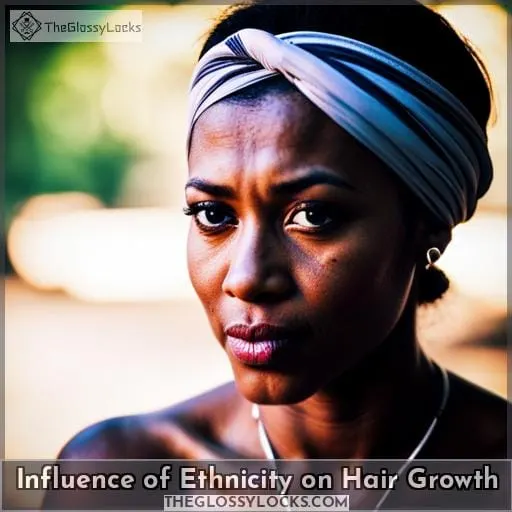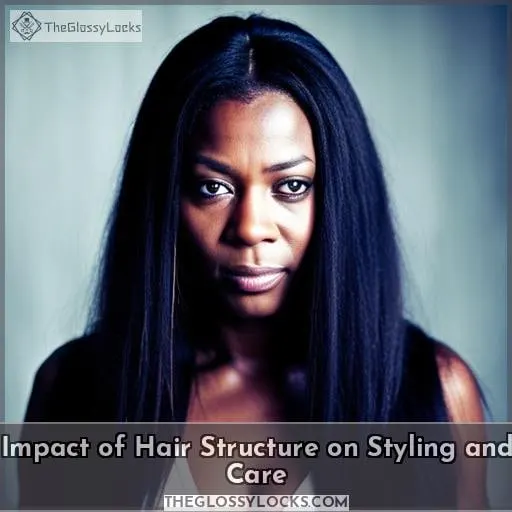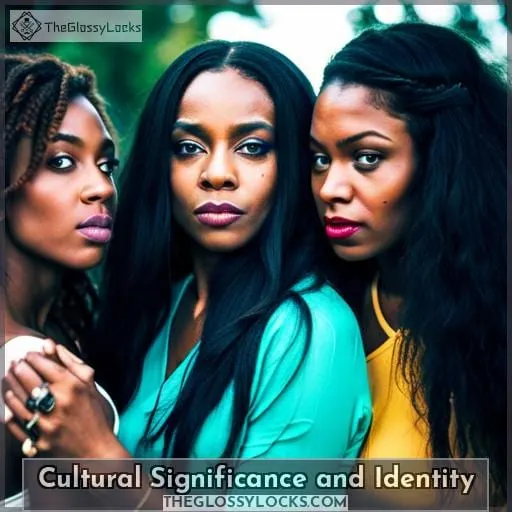This site is supported by our readers. We may earn a commission, at no cost to you, if you purchase through links.
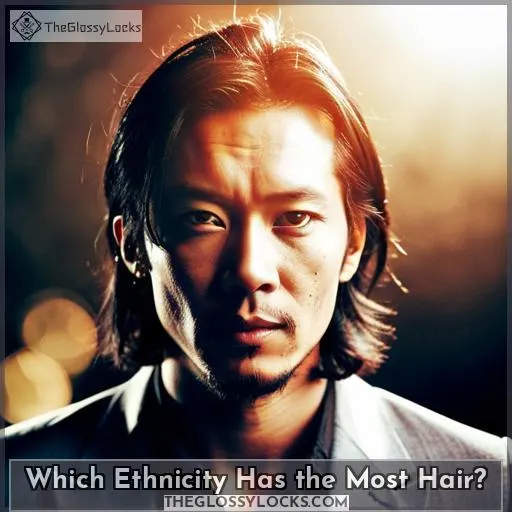
From different rates of growth to varying textures and colors, understanding how ethnicity plays a role in our locks can provide valuable insights into styling and care.
Delve into the cultural significance of hair, explore diverse practices for maintaining healthy strands, and gain a deeper appreciation for how our identity is intertwined with this precious asset.
Table Of Contents
- Key Takeaways
- Ethnic Hair Profiles
- Influence of Ethnicity on Hair Growth
- Impact of Hair Structure on Styling and Care
- Cultural Significance and Identity
- Frequently Asked Questions (FAQs)
- How does hair density vary among different ethnicities?
- What are the unique challenges and benefits of styling Asian hair?
- How does hair growth rate differ between Caucasians and Africans?
- What are some cultural practices and traditions related to hair care in African communities?
- How does hair structure impact the use of heat and chemical treatments for different ethnicities?
- Conclusion
Key Takeaways
- Caucasian hair has the highest density among ethnicities.
- Asian hair grows the fastest compared to other ethnicities.
- African hair has the slowest growth rate.
- Hispanic or Latino hair falls between the characteristics of Asian and Caucasian hair.
Ethnic Hair Profiles
Let’s explore the ethnic hair profiles to understand how different ethnicities differ in terms of hair structure, growth rate, and density.
Asian individuals typically have smooth and straight hair that grows at a faster rate compared to other ethnic groups.
Caucasian individuals may have diverse textures ranging from smooth to curly with the highest density among the three groups.
African individuals often have curly or frizzy textured hair with a slower growth rate but slightly higher density than Asian hair.
Hispanic or Latino individuals generally fall between Asian and Caucasian characteristics in terms of their hair profile.
Asian Hair Profile
Asian hair typically grows at the fastest rate, approximately 1.4 centimeters per month.
Asian hair has a unique growth pattern as it grows perpendicular to the scalp.
The shape of Asian hair is round and uniform, contributing to its smooth texture.
In terms of density, Asian hair has the lowest density among ethnic groups, but it compensates with its fast growth rate.
Caucasian Hair Profile
When it comes to hair profiles, Caucasians have a distinct set of characteristics that differentiate their hair from other ethnicities.
Caucasian hair is known for its cylindrical shape and has an average diameter of 65µm.
The average growth rate of Caucasian hair is about 1.2 centimeters per month, and graying occurs at an average age compared to other ethnicities.
Understanding these unique attributes can help in addressing concerns such as hair loss or maintaining healthy strands.
African Hair Profile
Continuing with our exploration of ethnic hair profiles, let’s delve into the African hair profile.
African hair is generally known for its curly or frizzy texture and black color. It grows almost parallel to the scalp, at a slower rate compared to other ethnicities, approximately 0.
The shape of African hair is flattened, and it has slightly higher density compared to Asian hair types.
Understanding these characteristics can guide natural hair care practices for individuals with type 4C or similar textured Afro-textured hairstyles.
Hispanic or Latino Hair Profile
Moving on to the Hispanic or Latino hair profile, let’s explore its unique characteristics and how they contribute to hair growth and care.
The Hispanic or Latino hair shaft is similar to Asian hair in shape. The diameter of this type of hair falls between that of Asian and Caucasian individuals.
The average growth rate for Hispanic or Latino hair is considered normal, while graying typically occurs later in life.
Influence of Ethnicity on Hair Growth
The influence of ethnicity on hair growth encompasses various factors such as:
- Hair growth rate
- Texture
- Color
- Shape
- Density
Different ethnicities exhibit distinct characteristics in these aspects of hair growth. For example, Asian individuals tend to have the fastest hair growth rate and smooth straight hair texture while African individuals typically have slower-growing curly or frizzy hair with lower density.
Understanding these differences can inform appropriate styling techniques and personalized care for different ethnic groups.
Hair Growth Rate
Now let’s delve into how hair growth rate is influenced by ethnicity.
- Hair Growth Rate:
- Asian hair grows at the fastest rate, approximately 1.4 centimeters per month.
- Caucasian hair follows with a growth rate of about 1.2 centimeters per month.
- African hair has the slowest growth rate, around 0.9 centimeters per month.
Understanding these differences in hair growth rates among ethnicities can help individuals tailor their care routines and styling practices to best suit their unique needs and preferences.
Hair Texture
As you delve into the influence of ethnicity on hair growth, it’s important to explore how different ethnic groups exhibit varying hair textures.
Asian hair is typically smooth and straight, while Caucasian hair can be smooth, wavy, or curly.
African hair is generally curly or frizzy in texture.
These differences in texture contribute to unique styling challenges and require tailored care routines.
Understanding these distinctions allows for better appreciation and management of diverse hairstyles across different ethnicities.
Hair Color
When it comes to hair color, different ethnicities exhibit varying shades and hues.
Asian hair commonly ranges from brown to black, while Caucasian individuals can have anything from blond to dark brown hair.
African hair tends to be naturally black in color.
Additionally, red and blonde hair are more commonly found among Caucasians due to genetic variations.
These differences in hair color contribute to the unique characteristics of each ethnicity’s appearance and cultural identity.
Hair Shape
You may be wondering, which ethnicity has the most hair?
Hair shape varies among different ethnicities.
Asian hair typically has a round and uniform shape, while Caucasian hair is oval in shape.
African hair, on the other hand, tends to have a flattened shape.
In terms of density, Caucasian hair has the highest density among these groups, while African hair has the lowest density.
Understanding these differences can help inform styling and care practices for each ethnicity’s unique needs.
Hair Density
Continuing from our previous discussion on hair shape, let’s now explore the influence of ethnicity on hair density.
Hair density varies among different ethnicities, with Caucasians having the highest density and Black people having the lowest.
Age and gender can also affect hair density, but ethnicity remains a significant factor. Understanding these differences can help individuals better understand their own unique hair characteristics and tailor their care routines accordingly.
Impact of Hair Structure on Styling and Care
When it comes to styling challenges, different ethnicities face unique experiences.
Asian hair’s uniform shape makes it easier to style and manage, while Caucasian hair’s diverse textures offer versatility in styling options.
African hair’s curliness can present its own set of challenges when it comes to styling.
Additionally, each ethnicity has specific needs when it comes to their haircare routines and maintenance practices.
Understanding these differences is crucial for providing effective care and achieving desired hairstyles across various ethnic backgrounds.
Styling Challenges
To style your hair, it’s important to consider the unique challenges that arise from the structure of different ethnicities’ hair.
These challenges include:
- Dealing with frizz and maintaining shine while heat styling
- Preventing breakage caused by chemical treatments
- Avoiding traction alopecia from tight hairstyles
Curly hair offers styling versatility but may require extra care to manage frizz.
Straight hair tends to have natural shine but can be prone to damage if not properly cared for during styling processes.
Haircare Routines
Moving on to haircare routines, it’s important to consider the impact of hair structure on styling and care. Different types of hair require different approaches when it comes to maintaining its health and appearance.
The frequency and products used in one’s haircare routine can greatly influence the condition of their locks.
Understanding your specific type of hair, whether it be Asian, Caucasian, African or Hispanic/Latino, can help you tailor your routine for optimal results and self-care practices that promote healthy-looking strands.
Heat and Chemical Treatments
When it comes to styling and caring for different hair types, heat and chemical treatments play a significant role in the impact of hair structure.
Heat damage can affect the texture of your hair, leading to dryness and breakage.
Chemical treatments like relaxers or dyes can alter the porosity and elasticity of your strands.
It’s important to be cautious with these treatments as they can cause damage if not done properly or used excessively.
Take care of your hair by using heat protectants, deep conditioning regularly, and consulting professionals for chemical services.
Haircuts and Shaping
If you want to know which ethnicity has the most hair, it’s important to consider how different hair structures impact styling and care.
Here are three key points to understand about haircut and shaping:
- Different ethnicities have diverse textures that allow for various haircut styles.
- Skilled professionals are often required for precise cutting of African hair due to its unique shape.
- Asian hair’s straightness lends itself well to precise cutting and shaping techniques.
Cultural Significance and Identity
Cultural significance and identity play a significant role in how individuals perceive their hair.
Different ethnicities have distinct cultural associations, leading to varied haircare practices, expressions of identity, and impacts on self-esteem.
Asian cultures often value smooth and dark hair as a symbol of beauty, while Caucasian societies embrace diverse perceptions of beauty reflected in different hair variations.
African cultures celebrate natural hair as an expression of cultural pride and individuality.
Understanding the cultural significance attached to different ethnicities’ hairstyles can foster appreciation for diversity and promote culturally sensitive approaches to maintaining healthy strands.
Cultural Associations
Continuing the exploration of the impact of hair structure on styling and care, let’s delve into cultural associations and their significance in relation to hair.
Hair holds great importance as a beauty ideal, cultural identity, form of expression, source of pride, and way to connect with others. Different ethnic groups have unique perceptions surrounding their hair that shape individual self-esteem and contribute to overall cultural norms.
Understanding these associations can foster appreciation for diverse expressions through hairstyles across cultures.
Haircare Practices
To maintain healthy and vibrant hair, it’s important to understand the unique haircare practices influenced by cultural significance and identity across different ethnicities.
- Cultural Haircare
Across different ethnicities, there exist specific rituals and traditions related to maintaining one’s mane that reflect both personal preferences as well as societal norms.
- Hair Texture
One’s natural hair texture varies depending on their genetic makeup, with individuals from different ethnic backgrounds having diverse textures ranging from smooth straight strands (common among Asians) all the way through wavy or curly tresses (often seen in Caucasians) or even tight coils (typical among Africans).
- Choice of Products
Due to the wide range of hair textures and conditions, it’s important to choose hair care products that are specifically designed for your hair type.
- Hairstyling
The way you style your hair can also have a significant impact on its health and appearance.
Establishing a regular hair care routine is essential for maintaining healthy hair.
Expression of Identity
When it comes to the expression of identity through hair, individuals from different ethnic backgrounds use their unique hairstyles and care practices as a means of cultural celebration and personal representation.
Hair serves as more than just a physical feature; it’s art, rebellion, empowerment, self-expression, and cultural identity.
From intricate braids to vibrant colors or natural afros that defy societal norms, hair plays a significant role in how people express who they’re and connect with their heritage.
Impact on Self-esteem
You may be wondering how hair impacts the self-esteem of individuals from different ethnic backgrounds.
Hair holds cultural significance and is often seen as a form of expression, a source of pride, and a marker of cultural identity.
For many people, their hair plays an important role in shaping their positive self-image. It can connect them to their heritage and allow them to feel connected with others who share similar experiences or traditions surrounding hair care and styling.
Frequently Asked Questions (FAQs)
How does hair density vary among different ethnicities?
Hair density varies among different ethnicities.
Caucasian hair has the highest density, followed by Asian hair falling in between, and African hair having the lowest density.
Understanding these variations can inform personalized care and styling practices.
What are the unique challenges and benefits of styling Asian hair?
Styling Asian hair offers a rhythmic dance of possibilities. Its smooth texture and uniform shape make it easier to manage, while its fast growth rate allows for experimentation with various styles.
How does hair growth rate differ between Caucasians and Africans?
African hair has the slowest growth rate, approximately 9 centimeters per month, while Caucasian hair follows with a growth rate of about
What are some cultural practices and traditions related to hair care in African communities?
African communities have cultural practices such as cornrows, tight hair ties, braiding, and weaves. These hairstyles are significant in expressing identity and pride. However, they can also contribute to traction alopecia if not done properly or excessively.
How does hair structure impact the use of heat and chemical treatments for different ethnicities?
Hair structure plays a significant role in how different ethnicities respond to heat and chemical treatments.
The varying shapes, textures, and densities of hair among ethnic groups can influence the effectiveness and potential damage caused by these styling methods.
Conclusion
To conclude, the ethnicity with the most hair varies depending on different factors such as hair growth rate, texture, color, shape, and density.
Asian, Caucasian, African, and Hispanic or Latino individuals each have unique hair profiles that contribute to their overall hair volume.
Understanding these ethnic hair profiles can help in styling and caring for different hair types.
Additionally, hair holds cultural significance and plays a role in expressing one’s identity.
By appreciating the diversity of hair, we can foster a deeper understanding of ourselves and others.

